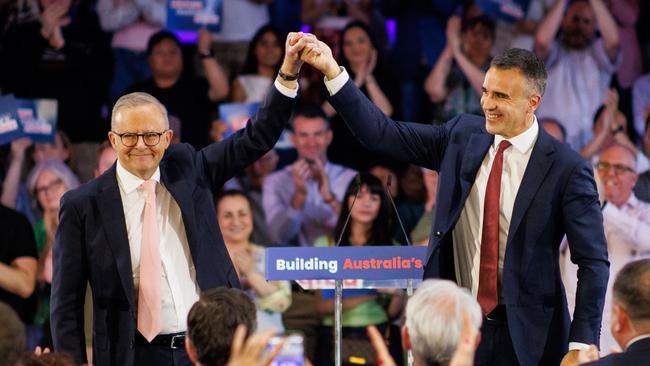Cost of student debt relief ‘hidden’ from budget bottom line
A surge in ‘off-budget’ spending is hiding the depth of Australia’s deficits, economists say, as the impact of Labor’s $16bn plan to slash student debts will be concealed from the budget’s bottom line.

A surge in “off-budget” spending is hiding the depth of Australia’s deficits, economists say, as the impact of Labor’s $16bn plan to slash student debts will be concealed from the budget’s bottom line.
In an attempted political reset by Anthony Albanese on Sunday, more than three million Australians with student debts will see them reduced by 20 per cent as Labor tries to ward off attacks that it is failing to address cost pressures facing households.
But due to Treasury’s accounting rules, the change will have a negligible effect on the budget bottom line, projected to plunge to a $28.3bn deficit in the current financial year, and instead will be tallied as part of so-called off-budget measures.
While both Labor and the Coalition have historically listed off-budget measures, the Albanese government has significantly ramped up such outlays.
In then-treasurer Josh Frydenberg’s final budget in March 2022, off-budget spending was projected at $33.7bn over five years. In Jim Chalmers’ May budget papers that figure had climbed to $80.5bn following the establishment of a range of energy and infrastructure investment vehicles, including the Future Made in Australia plan.
The Prime Minister – who will attempt to bring the debate back on to the economy in parliament this week – also unveiled plans to legislate guaranteed funding for 100,000 fee-free TAFE places a year from 2027.
With the Reserve Bank likely to hold interest rates at 4.35 per cent on Tuesday, Mr Albanese defended the government’s record on inflation and declared there were “new reasons for optimism and new proof the worst is behind us”.
“Our economic plan has prioritised helping people under pressure while also fighting inflation,” he said at a Labor rally on Sunday.
“This is an economic record we are proud of and more than that, it’s the foundation for building Australia’s future.
“This is about putting money back into your pocket and putting intergenerational equity back into the system.”
Economist Chris Richardson on Sunday branded Labor’s move to reduce student debts by 20 per cent as “dumb”, and accused it of hiding the debt writedown.
“Although the accounting will not show an extra $16bn of cash underlying deficit as a result of this decision, it should,” he said. “We are increasingly hiding our deficits from ourselves.
“The whole idea was always that something could go off-budget if it was going to pay for itself. For both the NBN and student loans, we’re increasingly failing that.”
The writedown in student debt, however, will add to net debt, projected to reach $552.5bn by mid-2025.
Independent economist Saul Eslake shared concern over the rise in off-budget spending, which had come to include ongoing expenses rather than one-off outlays.
“It really deserves more attention,” he said. “They shouldn’t be able to get away with hiding this stuff that most people don’t look at.”
Opposition Treasury spokesman Angus Taylor accused the government of “(following former Queensland premier) Steven Miles down the economic drain”.
“There are no free lunches in economics,” he said. “Under this policy, every Australian will continue to pay the price for Labor’s high interest rate, high inflation environment – but only a few will see the benefits.
“Labor is resorting to picking winners.”
Former Treasury official Peter Downes, now of Outlook Economics, was more supportive of the student debt plan, arguing the change would support intergenerational equity.
“It’s not totally politically cynical that they’ve pushed into off-budget spending … you need to focus on the quality of the measures,” he said.
“Students today are going to have to pay a whole pile of tax, plus pay back their HECS debt.”
Should Labor win the election, the measure will apply by June 1, 2025, to those who currently hold student debts, including those with HELP accounts, VET student loans, Australian apprenticeship support loans and other income-contingent loans.
As well, the 20 per cent student debt reduction will add about $600m over the four-year forward estimates period, a government spokesman said.
Greens education spokeswoman Mehreen Faruqi claimed the change was a result of its pressure on Labor, further demanding all student debts – which currently amount to $81bn – be cleared.
“We are proud of this win but let’s be clear, Labor’s plans still fall short of what’s needed,” she said. “All student debt should be wiped and university and TAFE should be free.”




To join the conversation, please log in. Don't have an account? Register
Join the conversation, you are commenting as Logout